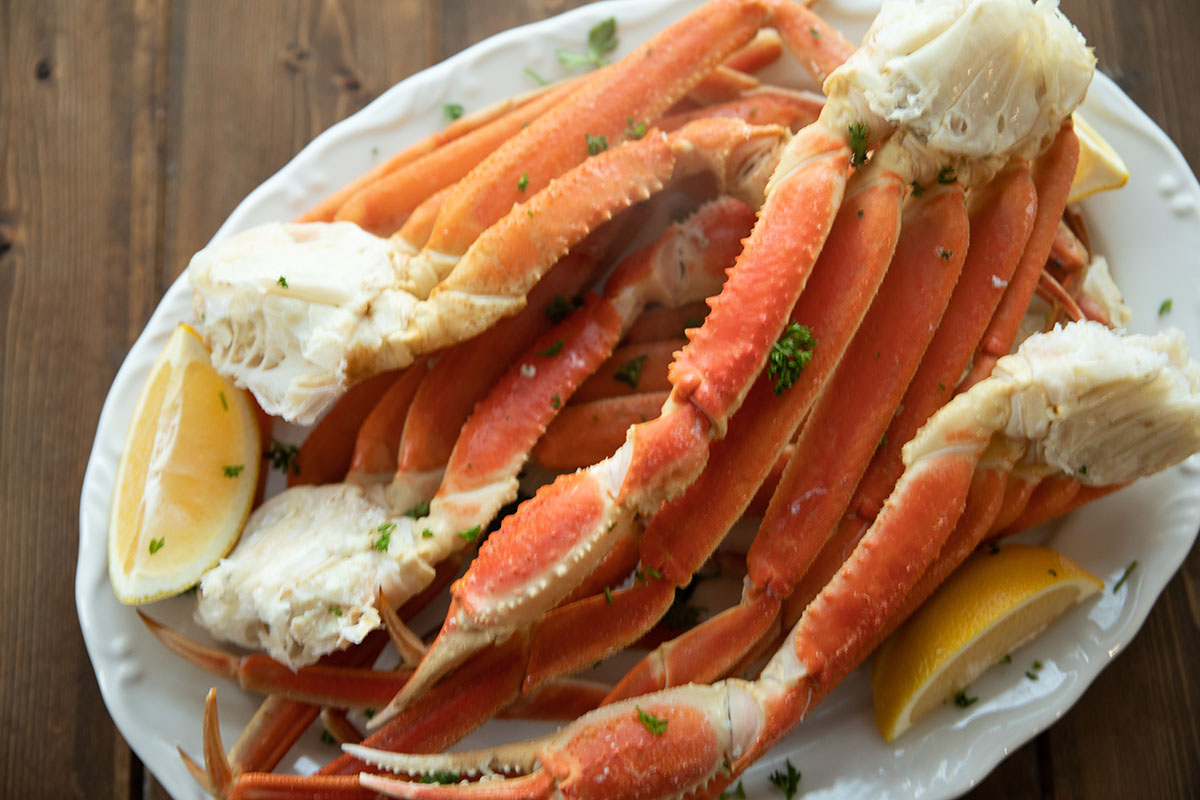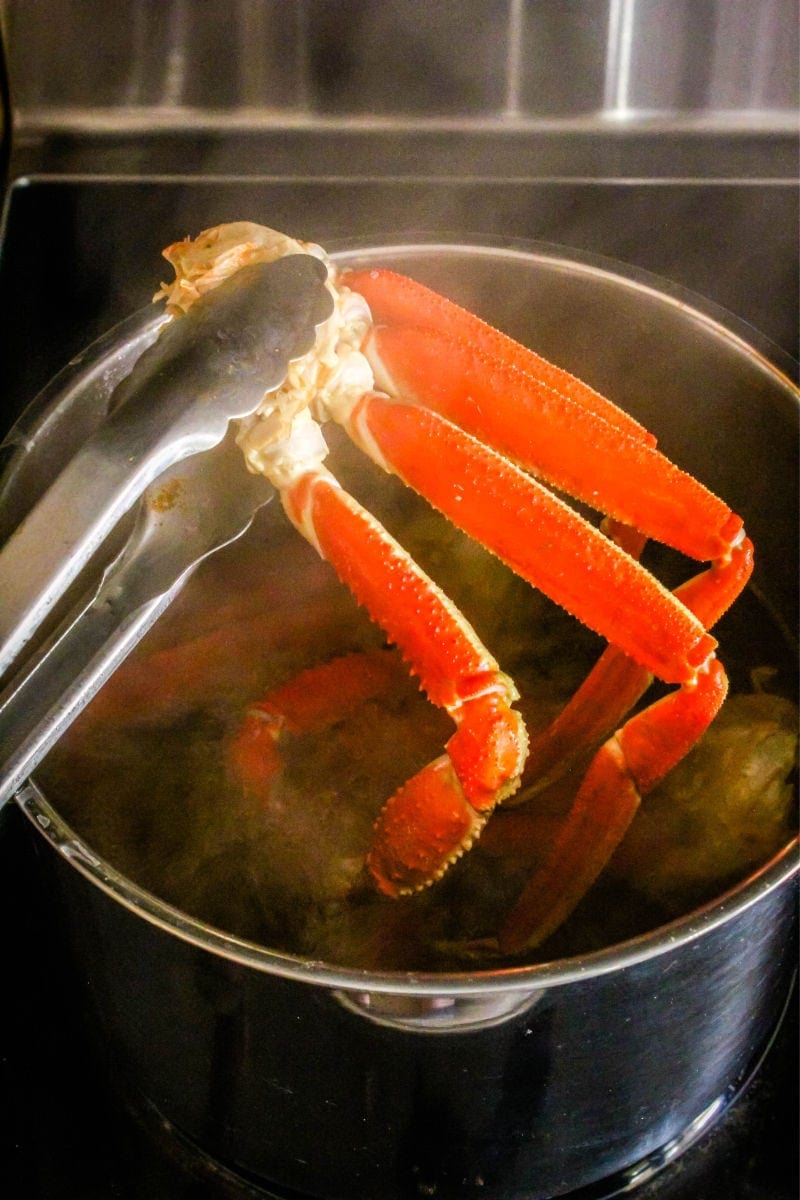Snow crab legs are a delicious and indulgent seafood treat that many people love. Their sweet succulent meat makes them incredibly tasty. While you can buy pre-cooked snow crab legs at the store learning how to properly boil them at home results in the best flavor and texture.
When it comes to boiling snow crab legs timing is everything. Boil them for too short and the meat will be undercooked and chewy. Boil them for too long and they’ll be tough and rubbery. So how long should you boil snow crab legs for optimal enjoyment? Follow this guide for tips on cooking times, doneness tests and techniques to boil snow crab legs just right every time.
How Long Does It Take To Boil Snow Crab Legs?
The exact boiling time depends mainly on whether the snow crab legs are frozen or thawed:
- For frozen snow crab legs, boil for 8-10 minutes
- For thawed snow crab legs, boil for 4-6 minutes
These times are for crab legs that are medium-sized, around 4-8 ounces each. Larger legs may take a minute or two longer. Smaller legs can be done as quickly as 3-4 minutes.
No matter the size, resist the urge to boil them longer thinking it’ll make them more tender. This overcooking causes snow crab legs to become unpleasantly rubbery in texture.
Test For Doneness
The best way to confirm snow crab legs are cooked through but not overdone is to test them. There are two simple ways to check for doneness:
-
Use tongs to remove one crab leg from the pot. Gently pull back the shell and peek at the meat. It should be opaque and flaky looking when fully cooked. If it still appears translucent, boil for 1-2 more minutes.
-
Insert a fork into the thickest part of a crab leg and twist gently. The meat should feel firm yet still be easy to pull apart. If it seems too stiff, continue boiling for another minute or so.
When in doubt, err on the side of slightly undercooked since the residual heat will finish cooking them.
Tips For Perfectly Boiled Snow Crab Legs
Follow these handy tips for flawlessly boiled snow crab legs every time:
-
Start with cold water – Lowering the crab legs into already boiling water can make the outsides overcook before the insides are done. Begin with cold water and bring to a boil.
-
Use enough water to cover the legs – They’ll cook more evenly if fully submerged in boiling water.
-
Don’t crowd the pot – Boil in batches if needed to allow room for the heat and water to circulate properly.
-
Add seasonings – Try Old Bay, lemon, garlic, peppercorns for extra flavor.
-
Gently add and remove legs – Use tongs or a slotted spoon so the shells don’t crack.
-
Check early and often – Test a thicker leg at 4 minutes before removing any.
-
Serve immediately – Enjoy them straight from the pot for the best taste and texture.
Reasons For Variations In Boiling Times
There are a few factors that can cause boiling times to vary:
-
Leg size – Larger, thicker legs need a little longer than smaller, thinner ones.
-
Frozen vs. thawed – Frozen legs require longer boiling than thawed ones.
-
Altitude – Increased altitude means water boils at lower temperatures, increasing cooking times.
-
How crowded the pot is – More room around each leg cooks faster than cramped, crowded legs.
-
Accuracy of timing – Starting the timer as soon as legs go into boiling water is key for precision.
So remain observant when boiling snow crab legs and always perform a doneness check for best results.
What Happens If You Over Boil Snow Crab Legs?
It’s easy to overcook snow crab legs since they boil so quickly. Going past the ideal cooking time can cause the following undesirable effects:
-
Rubbery, tough texture – The meat fibers shrink and squeeze out moisture, becoming chewy.
-
Stringy, dry meat – Overexposure to heat evaporates natural juices leaving meat fibrous.
-
Loss of flavor – Subtle sweetness becomes washed out the longer legs boil.
-
Cracked leg shells – Shells weaken and split open when boiled too long.
-
Nutrient loss – Extended boiling diminishes vitamins like B12, zinc, copper, and selenium.
For peak enjoyment, it’s always better to slightly undercook snow crab legs rather than overdo it.
Serving Perfectly Boiled Snow Crab Legs
Once boiled to tender, sweet perfection, here are some of the best ways to serve and enjoy snow crab legs:
-
Dipped in melted butter – The classic!
-
Splashed with fresh lemon juice – Brightens up the briny flavor.
-
Sprinkled with garlic salt or Old Bay seasoning – For extra zing.
-
Alongside crab crackers and pickers – To easily access the meat.
-
On a seafood platter – Surrounded by shrimp, lobster tails, mussels.
-
In a salad – Chilled legs over lettuce, tomatoes, avocado.
-
In pasta – Broken up leg meat tossed with linguine.
-
On pizza – Scattered over cheesy garlic bread crust.
-
In sandwiches and wraps – Teamed with mayo, lettuce, tomato.
However you choose to serve them, properly boiled snow crab legs are impossible to resist! Just be sure not to overcook them so you can enjoy their spectacular taste and texture.
Frequently Asked Questions About Boiling Snow Crab Legs
How can you tell when snow crab legs are done boiling?
Check for bright red leg shells, opaque and flaky meat, and meat that easily pulls apart with a fork. Legs that still appear translucent need more time.
Do you add salt or seasoning to the boiling water?
Yes, adding salt and spices like Old Bay infuses more flavor into the crab legs as they cook. Use about 1-2 tablespoons of salt.
Is it better to boil frozen or thawed snow crab legs?
Thawed legs cook more quickly and evenly. But frozen legs work too if you allow 8-10 minutes to compensate for the temperature difference.
What happens if I overcook the snow crab legs?
Overcooking makes the meat tough, chewy, and dry plus it diminishes the sweet flavor. It’s better to slightly undercook them.
How long do snow crab legs last after boiling?
Boiled snow crab legs will keep for 2 to 3 days tightly wrapped in the fridge. Reheat gently in simmering water or by steaming to serve again.
For Delicious Yet Simple Snow Crab Legs, Boil Them Just Right
Preparing snow crab legs by boiling is easy, quick, and results in delicious seafood every time when done properly. By following the suggested cooking times and performing a doneness test, you can master the art of boiling snow crab legs perfectly. A few simple guidelines will help you avoid under or overcooking them.
In about 10 minutes, you can enjoy these sweet and tender snow crab legs on their own or incorporated into various recipes. Just be sure not to actually boil them for that long! Keeping a close eye on the pot and frequently testing for doneness ensures snow crab leg meat that melts in your mouth. So grab your crab bib and crackers, and get ready to impress your family or guests with your flawlessly boiled snow crab legs.

How To Boil Snow Crab Legs
See the recipe card below for full, detailed instructions
This method is my go-to and the one I include in detail in the recipe card below. In this section, however, I’ll include tips for steaming and grilling as well.
- Season a large pot of boiling water with salt and Old Bay.
- While the water is coming to a boil, start melting butter in a small saucepan over medium-low heat. Cook the butter until it gets foamy, it only takes a minute. Remove the pan from the hot burner and let the butter hang out in the pan for 5 minutes while the crab cooks.
- Next, place the crab legs into the boiling water. (I use tongs!) Let the crab boil for 5 to 6 minutes until it’s warmed and fragrant.
- Then, use tongs to remove the crab from the pot and place on dinner plates.
- Use a spoon to remove any solids floating on top of the butter. Then pour the butter into two small bowls.
- Sprinkle a little more Old Bay over the crab legs (optional but I like to do this) and then serve immediately with the clarified butter and lemon wedges.

How To Cook Crab Legs
There are several methods you can use to cook crab legs. Boiling is the most common, but you could also steam or grill them.
I like to make the clarified butter while the crab cooks so everything is done together. The steps below talk you through making both the butter and crab at the same time.
